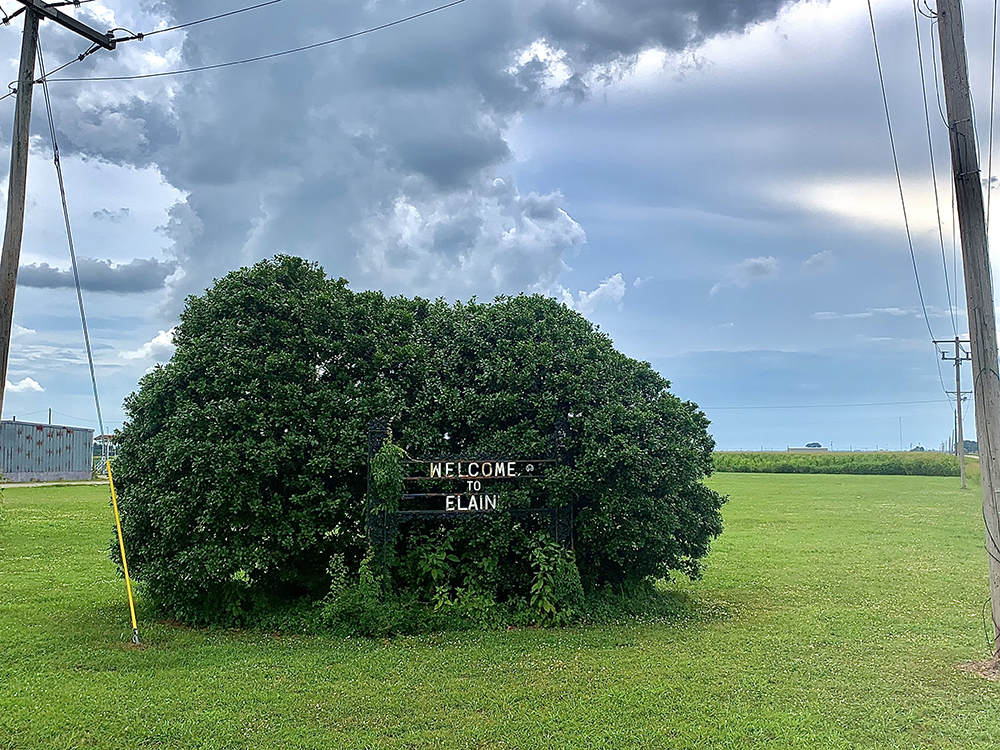Join me today for a trip to Elaine, Arkansas. It’s a long drive, and I could use some company.
As Highway 61 winds its way down the bluffs to the big-sky alluvial plain of the Mississippi Delta, towering clumps of clouds drift on the western horizon, distant rainstorms visible in the morning light. We’ll probably get wet later.
In Tunica County, signs for casinos appear. Some are thriving, others are ghostly shells, losers on the gaming wheel of fortune that began spinning 30 years ago. The outlet mall south of town, once a thriving retail mecca, now features several empty storefronts, the formerly heady thrill of wandering through J.Crew, Victoria’s Secret, and Nautica having been replaced by porch-box fairies in FedEx trucks.
We turn onto Highway 49, a slim two-lane running string-straight to the Helena Bridge, a narrow and rusty looking structure with kudzu and trumpet vines adorning the side rails. It does not inspire confidence. Once across, we take the Great River Road 20 miles south to Elaine, where in 1919, the greatest race massacre in U.S. history occurred. But you knew that. Didn’t you?

Late winter through early autumn of 1919 has become known as “Red Summer,” a time when white supremacist terrorism and racial riots took place in more than three dozen cities across the U.S. — and in one small town, Elaine, Arkansas — where we are now parked in front of a vacant building with a sign that says “Birdhouse Capital of the World.” There are no people in sight. In 1919, thanks to Jim Crow election laws, Black Americans couldn’t vote, hold office, or serve on juries. At the same time, thousands of African-American soldiers were returning from World War I and were beginning to feel resentment at the racism they came home to. The nascent NAACP had begun to speak out for racial justice.
The reaction to Black activism was swift and brutal. The KKK and other groups began ginning up violence and hate against the “negroes” for “spreading socialism.” Jingoistic newspapers around the country fed the fire with articles about “armed negroes in revolt.” Racial violence soon broke out in Chicago, Omaha, Tulsa, Washington, D.C., and more than 30 other cities. Black communities were destroyed. Hundreds were killed. Lynchings were common.
In Phillips County, Arkansas, 100 residents of Elaine held a meeting of the Progressive Farmers and Household Union of America in a church north of town on September 30, 1919. Three white men monitored the gathering. Shots were fired and returned. A white security officer was killed; a deputy sheriff wounded. The word went out in Helena that there was an “armed negro revolt” underway.
Over the next couple of days, as many as 1,000 vigilantes, soldiers, and police swarmed into Elaine and committed horrific acts of violence. From an eyewitness account:
“Soldiers in Elaine committed one murder after another with all the calm deliberation in the world, either too heartless to realize the enormity of their crimes, or too drunk on moonshine to give a continental darn. … several hundred of them began to hunt negroes and shotting [sic] them as they came to them.”
Accounts of how many Black men, women, and children were killed range from 150 to 800. No one knows for sure, but there is little doubt that it was the worst race massacre in U.S. history. The ensuing kangaroo court trial and imprisonment of 12 Black “rioters” changed U.S. civil rights history and is worth your time to learn about, because like most Americans, you’ve probably never heard about any of it.
Thanks to the folks at the Elaine Legacy Center, that’s changing. They are organized and pushing forward with presentations, lectures, and other programs to restore life to the area and tell its story. On September 30th, there will be a service to honor the victims of the massacre. I’m going to write more about Elaine and the Legacy Center later this summer. I hope you’ll join me for a return trip.
